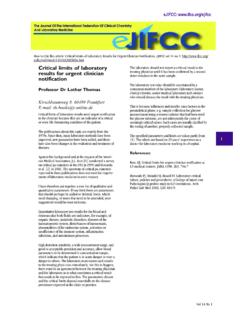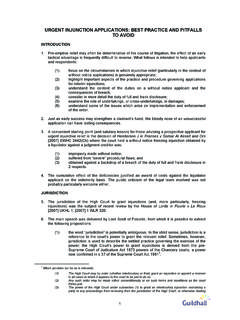Transcription of Riches in the Niches: Target Demographics for …
1 Riches in the Niches: Target Demographics for Urgent care Alan A. Ayers, MBA, MAcc Vice President, Concentra Urgent care Content Advisor, Urgent care Association of America Dallas, Texas In the era of mass media specifically network television and Top 40 radio marketing wisdom was that a product should have universal appeal. Advertisers like Sears, McDonalds, and Procter & Gamble through catchy jingles and celebrity spokespersons took to the airwaves offering one size fits all solutions to the American public. While these tactics were successful from the 1950s through the 1990s, Americans have since become discontented that a little bit of something for everyone equates to not much good for anyone.
2 Not only have Americans become increasingly polarized in their education, needs, values and attitudes, new technology including email, interactive websites and social media have facilitated a laser-like focus on specific consumer niches. As a result, mass has given way to powerful brands with unique appeal to teens, tweens, techies, foodies, greenies, fashionistas, soccer moms, outdoor enthusiasts, and thousands of other self-identified cohorts. Over the past 20 years, the retail environment has likewise migrated from mass to niche as general merchandise stores appealing to everyone have lost marketshare to specialty stores and lifestyle websites focused on one or more Target segments.
3 Health care s equivalent to the historic mass channel is the General Hospital providing cradle to grave care regardless of one s age, life stage, income, or personal health while the niches include retail clinics, telemedicine, self-triage and diagnosis, integrative medicine, and even non-medical providers. General merchandiser seeking universal appeal. Specialty retailer appealing to self-identified niche segments. General hospital offering comprehensive, cradle-to-grave care to everyone in the community. Specialty medical provider targeting specific patient use occasions. Health care delivery in the United States can be compared to retail in its shift from mass to niche.
4 Focusing on the Niches Put yourself in the shoes of a consumer buying a discretionary product like a bicycle where do you think you would find greater selection, sales guidance, and post-sale service? At a department store or specialty bike shop? The department store likely has 8-10 models versus 30-40 at the bike shop and whereas the department store staff has received nominal (at best) product training, bike shops are typically staffed with bike enthusiasts with plenty of first-hand product experience. The same analogy applies to where one goes for urgent care as opposed to a general hospital, consumers should have a better experience at a facility focused solely on providing convenient, timely care for episodic injury and illness.
5 But despite being a niche provider of medical services, many urgent care centers act like the general merchandiser attempting to attract anyone in the community who may have a medical need. Not only does raising such universal awareness require an oversized advertising budget, such is inefficient because not everyone in the community can or will utilize the center. The better strategy is to identify the niches most likely to use urgent care and Target those groups specifically. For instance, does your center accept all commercial insurance, Medicaid, Medicare, and offer affordable cash pay options? Are there individuals in the community who are more or less active, more or less prone to injury or illness, or who are likely to not have established primary care provider relationships?
6 Are your providers and staff fluent in one or more foreign languages? The more that an urgent care center can tailor its service offering to the needs of its Target patients, the more successful it will be. A Primer on Demographics Demographics are factors that describe individuals such as their age, education, employment, and relationship status. While Demographics are often correlated with behavior and attitudes they alone are insufficient to sum up individuals. Consider, for example, the following charts depicting women aged 25-34. They may be married, living with a partner, or single which may be unrelated to whether they have one or multiple children. Decisions involving marriage and children at a young age frequently determine a woman s education, career progression, and health insurance coverage.
7 The following pictures show further that women in the same age cohort may live very different lifestyles and thus have very different health care needs. The frequency of use (affecting number of visits to your center), acuity and type of injury or illness presenting (affecting coding and charges per visit), and the presence and type of insurance payer (affecting reimbursement rates) can be expected to vary significantly among these women. It is likely that an urgent care center will be positioned to serve some of these women better than others, some will have more convenient or affordable health care options available to them, and some may be unprofitable for the urgent care center to serve.
8 Three women in the same age demographic with very different health care needs. Who Are Urgent care s Target Demographics ? Typically we find physician-owned freestanding urgent care centers located in suburban areas, appealing to middle- and upper-income married homeowners with children. The reasons for targeting these Demographics are intuitive Children get sick and injured more frequently than adults Educated consumers tend to be more aware of urgent care as a cost-saving alternative to the ER Employed individuals are more likely to have private health insurance that covers urgent care visits Homeownership indicates affluence and stability in a community Suburban families are starved for time and value convenience Target Demographics mean that a segment has a higher propensity to use urgent care than other segments.
9 By targeting high-use segments, an urgent care center can be more deliberate in site selection and more efficient and effective in its marketing activities. It doesn t mean that an urgent care center s clientele is limited to this segment. In fact, urgent care centers can be found almost anywhere, appealing to range of demographic segments. For example, a physician-owned urgent care center in an urban area might find a niche among young, single upwardly rising professionals, a suburban franchised center may reach out to recent immigrants without health insurance, an urban hospital-affiliated urgent care may divert low-acuity Medicaid populations away from its emergency room to reduce congestion and wait times, or a rural health center may provide health care access in communities too small to support an emergency room.
10 Such models tend to have a very specific purpose unique to their providers, investors, or sponsors and align their Target segments accordingly. Appealing to Key Decision Makers Not only is it important to identify the demographic segments an urgent care center serves, but within those segments, marketing should be targeted at key decision makers. Historically health care decisions in suburban married families are made by women. So what can an urgent care operator do to better appeal to women, and particularly younger women aged 25-34 who will be the future healthcare decision makers? We ll start with three hypotheses regarding women in the age 25-34 cohort: Many do not understand what urgent care is or when to use it.






